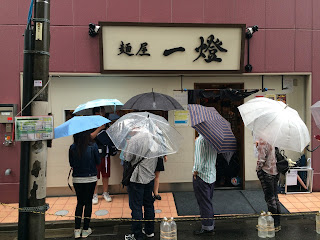Our ramen journey in Hokkaido continued. After going
to Saimi, we went to Susukino in Sapporo. This area seems just like Kabukicho in Shinjuku. Two bowls of ramen sounded crazy for my tiny woman’s body, but we
came all the way here, so my doubts blew away very fast.
Hearts
got a few local beers in Susukino, and after it got dark, we headed to Shingen.
Shingen is originally from Ishikari, midwest Hokkaido. Because of the fishermen
in this cold area, Shingen is famous for Ishikari-nabe, which is a miso-based hot pot. The miso ramen must be popular after drinking, but they serve
various kinds of ramen. Here are parts of the menu.
Echigo---Kara
miso(spicy)
Shinshu---Koku
miso(rich)
Tosa---Assari
shio(light)
Satsuma---Kotteri
shio(rich )
Owari---Assari
shoyu(light)
Mito---Kotteri shoyu(rich)
These
interesting names are feudal domains in Edo era of Japan. Not coincidentally, Shingen is also the name of a legendary daimyo whose attempts to rule the country have been chronicled in films, dramas, and video games. Conquer all the bowls and become the Shogun of Susukino.
We heard the shio at this Shingen was their specialty, and since we also we just ate miso at Saimi, we both ordered shio. Tosa (light)...
 |
| Tosa (735yen) |
...and Satsuma (rich).
 |
| Half Satsuma (525yen) |
I prefer Satsuma more than Tosa. Even the half-sized bowl was bigger than I
expected; just seeing it made my stomach stuffed, but once I sipped the soup, I oddly
kept eating. The rich bowl has what appears to be a soup closer to tonkotsu in its consistency, but the shio tare gives the bowl a creamy, buttery flavor that is strangely not salty at all.
I had never eaten such a creamy shio before, and the curly egg noodles go
fantastically well with the soup. The noodles seemed like they were dancing on my lips.
When I hear “shio,” I always
imagined a transparent soup, but Shingen's creamy shio was shockingly good. I cannot describe Shingen in Susukino as beautiful, but I really like the sticky, oily floor and its old-time shokudo (cafeteria) atmosphere. What both Hearts and I liked more is that we can order half-sized ramen. It is a really reasonable choice for ramen hunters, small eaters, or as post-drinking ramen. Even after a couple months have passed from our trip, Shingen stays in my heart.
Sapporo, Chuo-ku, Minami 6-Jo, Nishi-8
Closest stn: Higashi-Honganjimae
Open from 1130-130am
Lum




















































